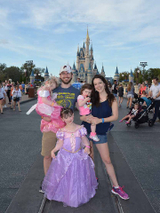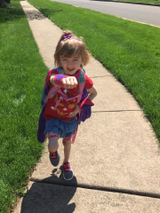Severe Congenital Neutropenia: Selene’s Story
Severe Congenital Neutropenia: Selene’s Story
Selene had recurring ear infections and fevers as a baby, but the mysterious welts that appeared on her body when she was 9 months old were something new. Many appointments later, Selene was diagnosed with severe congenital neutropenia, a rare disorder in which the body can’t fight off bacterial infections.

Selene’s parents did everything in their power to keep their daughter healthy. But it was Selene’s then 4-year-old sister, Ainsley, who gave her what she needed to get better: her bone marrow. The bone marrow transplant introduced Ainsley’s normal infection-fighting cells into Selene’s body, where they began creating healthy new blood cells.
“Before medical treatment was available, most babies with this didn’t make it past age 2,” says Selene’s mother, Jennifer. “When they called and told us Ainsley was a match, holy moly did we cry! That was awesome.”
Searching for answers

Jennifer and her husband, Dan, were at a family wedding with their two daughters when Selene fell ill and developed large, rock-hard welts on her sides, thigh and ankle. The couple packed up the car and drove straight to the emergency room of their local hospital. Selene was given an antibiotic and her parents set out on a months-long quest to find the cause.
It was a dermatologist at Children’s Hospital of Philadelphia (CHOP) who first suspected a blood disorder and invited a colleague from Immunology to review Selene's case. The doctors encouraged the family to get blood work done on Selene and referred the family to the hospital's Pediatric Comprehensive Bone Marrow Failure Center, part of the Division of Hematology. By then, eight months had passed since the welts first appeared. Selene’s blood was tested, and that evening, Jennifer received a call from the division.
“Literally, the first words out of the doctor’s mouth were, ‘Does Selene have a fever?’” Jennifer remembers. The doctor told her that a body temperature over 100 degrees could quickly become life-threatening because Selene had a shortage of neutrophils, a type of white blood cell that fights infection. The welts were caused by bacterial infections in Selene’s skin.
Jennifer and Dan kept a close eye on their daughter, who remained fever-free, and a few days later, met with Helge Hartung, MD, an attending physician in the Pediatric Comprehensive Bone Marrow Failure Center. Bone marrow failure syndromes are diagnostically and therapeutically challenging. They occur when the bone marrow — the soft, spongy material in the center of the bones — doesn’t produce enough healthy blood cells to keep up with the body’s needs.
Dr. Hartung told them the disorder would not correct itself and described the treatment options, which included a bone marrow transplant. Because siblings have a 25 percent chance of being a donor match — far greater than someone unrelated — Dr. Hartung referred the family to Timothy S. Olson, MD, PhD, who started the transplant process and recommended testing Ainsley’s blood to see if she would be a suitable donor for her little sister.
The couple opted to start Selene on daily injections of a bone marrow stimulant while they researched transplants. The medicine would speed up the maturation of neutrophils in Selene’s body and help her fight off bacterial infections.
Five months later, Ainsley’s blood was tested during her annual physical. She was a perfect bone marrow match for her little sister.
The bone marrow transplant
Selene’s transplant was scheduled for March 2015, exactly one year after her diagnosis and two months before Jennifer was due to give birth to the couple’s third child.
Selene was admitted to CHOP for 10 days of chemotherapy to suppress her immune system and prepare her body to accept her sister’s bone marrow cells. Selene loved to run through the hallways during her first week in the hospital, when she still had plenty of energy. Then her blood counts bottomed out and she grew weak. Her body was ready for the transplant.
Ainsley took her role as bone marrow donor seriously.
“She said she knew she had to be brave. We kept telling her we were proud of her and we loved her,” Jennifer says. “She was brave and wonderful the whole time. She was such a champ.”
The Blood and Marrow Transplant Program team harvested Ainsley’s bone marrow from her hip and infused it into Selene’s body. While Ainsley stayed with her grandparents, Jennifer and Dan remained at the hospital with Selene. Each day, they anxiously watched the nurses chart Selene’s blood count.
“It was the only way you could measure anything, with these numbers,” Jennifer says. For six days, the numbers remained low. “Then the most amazing thing is they all started going up — hemoglobin, platelets, neutrophils. They started going up and up and up.”
Improvement, then an unexpected setback

By her last week in the hospital, Selene was running through the corridors again. On April 1, her parents brought her home with a strict quarantine and monitoring from the bone marrow transplant team. Selene’s baby sister, Kalina, was born in May.
“It couldn’t be more perfect. Selene was quarantined anyway, so it was me, Selene and Kalina. I think she was the medicine we all needed,” Jennifer says of the newborn.
Selene continued to gain strength and was thriving by the one-year anniversary of her transplant. Her doctors were thrilled. Her blood count numbers were “fantastic,” Jennifer remembers.
Then Selene grew whiny. She insisted on sleeping with her parents at night; she didn’t want to walk her big sister to the bus stop. During a visit to Ainsley’s kindergarten class, Jennifer flattened Selene’s hand to trace her fingers on paper. The little girl screamed. Jennifer realized Selene’s hands were cupped.
Selene had developed graft-versus-host-disease (GVHD), a risk after transplant. The transplanted donor cells were attacking her joints.
Selene’s bone marrow transplant team treated the GVHD with a steroid and oral chemotherapy. They ordered physical therapy and occupational therapy for Selene at CHOP’s Specialty Care & Surgery Centers in King of Prussia and Bucks County.
A year later — after six months of chemotherapy and 12 months of PT and OT — Selene was a whole new kid. The medications did their job and the therapy strengthened her body. Once a shy preschooler, she “busted out of her shell” in time to start pre-K, Jennifer says.
“That’s when we finally could breathe a sigh of relief. She was happy, learning and starting to play,” she says.
The future is bright

Today Selene is a helpful and hard-working 6-year-old who loves to vacuum, fold laundry and put away clothes. She also knows how to have fun. Selene taught herself to ride a bicycle and enjoys spending time with her sisters, coloring, playing with dolls and swinging outside.
She doesn’t remember the bone marrow transplant or her long hospital stay, but she knows about it from the many pictures her parents took during that time.
“I have a lot of pictures of Selene sitting by the front door watching Ainsley leave and go places,” Jennifer says of the months her middle daughter had to stay safe from germs. That’s behind her now, and there’s no limit to what Selene can do.
“I just want her to find something that she loves and to do it with everything she’s got,” says Jennifer.